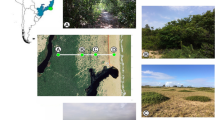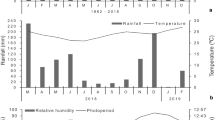Abstract
Abiotic fluctuations in montane ecosystems trigger changes in the hydric functional traits of tree species. These variations are better recognized in tree species inhabiting montane humid ravine slopes with different elevation, as is the case of many areas across the Mexican Neotropical montane forests. Little is known about the response of tree towards elevation gradients and abiotic changes. In this study, we analyzed the leaf morphological variation of two rare and Mexican endemic Symplocos species (S. coccinea and S. speciosa) occurring eastern Mexico on sites with different microclimate and elevation but similar floristic composition. We quantified how the abiotic factors (i.e. canopy openness, soil temperature, soil moisture, and litter depth) and site elevation influence the leaf traits of these tree species. Symplocos coccinea (with toothed leaf margins) is adapted to high humid conditions and high canopy coverage, while S. speciosa (with almost entire leaf margins) is resilient to environments with moisture deficit and high temperatures. Process-based research with fine-spatial scales at montane ecosystems are needed to understand the resilience and morphological variations of montane tree species under climate change worldwide. In this study, we confirmed that the Symplocos leaf morphological traits (i.e. leaf length, leaf width, leaf shape index, leaf base angle and vein density) are strongly influenced by abiotic conditions (i.e. canopy openness, litterfall depth, soil moisture and soil temperature).





Similar content being viewed by others
References
Abe N, Yamada T (2008) Variation in allometry and tree architecture among Symplocos species in a Japanese warm-temperate forest. J Plant Res 121(2):155–162
Alcántara-Ayala O, Luna-Vega I, Velázquez A (2002) Altitudinal distribution patterns of Mexican cloud forests based upon preferential characteristic genera. Plant Ecol 161(2):167–174
Alcántara-Ayala O, Oyama K, Ríos-Muñoz CA, Rivas G, Ramírez-Barahona S (2020) Morphological variation of leaf traits in the Ternstroemia lineata species complex (Ericales: Penthaphylacaceae) in response to geographic and climatic variation. PeerJ 1:e8307. https://doi.org/10.7717/peerj.8307
Aldrich M, Billington C, Edwards M, Laidlaw R (1997) A global directory of tropical montane cloud forests. IUCN-WCMC, Cambridge
Arlot S, Celisse A (2010) A survey of cross-validation procedures for model selection. Stat Surv 4:40–79. https://doi.org/10.1214/09-SS054
Blackman CJ, Brodribb TJ, Jordan GJ (2010) Leaf hydraulic vulnerability is related to conduit dimensions and drought resistance across a diverse range of woody angiosperms. New Phytol 188(4):1113–1123. https://doi.org/10.1111/j.1469-8137.2010.03439.x
Borcard D, Gillet F, Legendre P (2018) Numerical ecology with R. Springer, New York
Callis-Duehl K, Vittoz P, Defossez E, Rasmann S (2017) Community-level relaxation of plant defenses against herbivores at high elevation. Plant Ecol 218(3):291–304. https://doi.org/10.1007/s11258-016-0688-4
Dang-Le AT, Edelin C, Le-Cong K (2013) Ontogenetic variations in leaf morphology of the tropical rain forest species Dipterocarpus alatus Roxb. ex G. Don. Trees 27(3):773–786
FAO-UNESCO (1988) Soil map of the World. Revised legend. World Soil Resources Report 60, FAO-UNESCO, Rome
Flores-Franco G, Jiménez-Ramírez J, Mora-Jarvio M (2017) Distribution and diversity of Fagaceae in Hidalgo, Mexico. Bot Sci 95(4):660–721
García-Gómez EI (2019) Caracterización anatómica y arquitectónica foliar de dos especies de Ternstroemia mutis ex L. f. (Ternstroemiaceae) distribuidas en los bosques templados humedos de México. Tesis de licenciatura. Universidad Nacional Autónoma de México, Mexico.
Givnish T (1979) On the adaptive significance of leaf form. In: Solbrig OT (ed) Topics in plant population biology. Macmillan Education, London, pp 375–407
Givnish TJ (1984) Leaf and canopy adaptations in tropical forest. Physiol Ecol Plants Wet Trop 12(Sugden 1982):51–84. https://doi.org/10.1007/978-94-009-7299-5
Goldsmith GR, Matzke NJ, Dawson TE (2013) The incidence and implications of clouds for cloud forest plant water relations. Ecol Lett 16(3):307–314. https://doi.org/10.1111/ele.12039
González-Espinosa M, Ramírez-Marcial N, Galindo-Jaimes L (2006) Secondary succession in montane pine-oak forests of Chiapas, Mexico. In: Kappelle M (ed) Ecology and conservation of Neotropical montane oak forests. Springer, New York, pp 209–221
González-Espinosa M, Meave JA, Lorea-Hernández FG, Ibarra-Manríquez G, Newton AC (2011) The red list of Mexican cloud forest trees. Fauna & Flora International, Cambridge
Graham A (1976) Studies in Neotropical paleobotany. II. The Miocene communities of Veracruz, Mexico. Ann Missouri Bot Gard 4:787–842
Guerin GR, Wen H, Lowe AJ (2012) Leaf morphology shift linked to climate change. Biol Lett 8(5):882–886. https://doi.org/10.1098/rsbl.2012.0458
Hu J, Riveros-Iregui DA (2016) Life in the clouds: are tropical montane cloud forests responding to changes in climate? Oecologia 180(4):1061–1073. https://doi.org/10.1007/s00442-015-3533-x
Kappelle M (2006) Ecology and conservation of Neotropical montane oak forests. Ecological studies. Springer, Berlin
Kelly LM, Almeda F, Fritsch PW (2016) A taxonomic revision of Mexican and Central American Symplocos (Symplocaceae). Phytotaxa 264(1):1–115
Körner C (2007) The use of “altitude” in ecological research. Trends Ecol Evol 22(11):569–574. https://doi.org/10.1016/j.tree.2007.09.006
Körner C (2012) Alpine treelines functional ecology of the global high elevation tree limits. Springer, Basel
Körner C, Paulsen J (2004) A world-wide study of high altitude treeline temperatures. J Biogeogr 31(5):713–732. https://doi.org/10.1111/j.1365-2699.2003.01043.x
Li Y, Zou D, Shrestha N, Xu X, Wang Q, Jia W, Wang Z (2020) Spatiotemporal variation in leaf size and shape in response to climate. J Plant Ecol 13(1):87–96. https://doi.org/10.1093/jpe/rtz053
Luna-Vega I, Alcántara-Ayala O, Espinosa-Organista D, Morrone JJ (1999) Historical relationships of the Mexican cloud forests: a preliminary vicariance model applying Parsimony analysis of endemicity to vascular plant taxa. J Biogeogr 26(6):1299–1305. https://doi.org/10.1046/j.1365-2699.1999.00361.x
Luna-Vega I, Alcántara-Ayala O, Contreras-Medina R, Ponce-Vargas R (2006) Biogeography, current knowledge and conservation of threatened vascular plants characteristic of Mexican temperate forests. Biodivers Conserv 15(12):3773–3799. https://doi.org/10.1007/s10531-005-5401-1
Markesteijn L, Poorter L, Bongers F (2007) Light-dependent leaf trait variation in 43 tropical dry forest tree species. Am J Bot 94(4):515–525. https://doi.org/10.3732/ajb.94.4.515
Midolo G, De Frenne P, Hölzel N, Wellstein C (2019) Global patterns of intraspecific leaf trait responses to elevation. Glob Change Biol 25(7):2485–2498. https://doi.org/10.1111/gcb.14646
Milla R, Reich PB (2011) Multi-trait interactions, not phylogeny, fine-tune leaf size reduction with increasing altitude. Ann Bot 107(3):455–465. https://doi.org/10.1093/aob/mcq261
Oksanen J, Blanchet FG, Friendly M, Kindt R, Legendre P, McGlinn D, Minchin PR, O’Hara RB, Simpson GL, Solymos P, Stevens MHH, Szoecs E, Wagner H (2016) vegan: community ecology package. R package version 2.4-3. R Foundation for Statistical Computing, Vienna
Oliveira RS, Eller CB, Bittencourt PRL, Mulligan M (2014) The hydroclimatic and ecophysiological basis of cloud forest distributions under current and projected climates. Ann Bot 113(6):909–920. https://doi.org/10.1093/aob/mcu060
Peel MC, Finlayson BL, McMahon TA (2007) Updated world map of the Köppen–Geiger climate classification. Hydrol Earth Syst Sci 11(5):1633–1644. https://doi.org/10.5194/hess-11-1633-2007
Pfennigwerth AA, Bailey JK, Schweitzer JA (2017) Trait variation along elevation gradients in a dominant woody shrub is population-specific and driven by plasticity. AoB PLANTS. https://doi.org/10.1093/aobpla/plx027
Rahbek C, Borregaard MK, Antonelli A, Colwell RK, Holt BG, Nogues-Bravo D, Rasmussen CMØ, Richardson K, Rosing MT, Whittaker RJ, Fjeldså J (2019) Building mountain biodiversity: geological and evolutionary processes. Science 365(6458):1114–1119. https://doi.org/10.1126/science.aax0151
Read QD, Moorhead LC, Swenson NG, Bailey JK, Sanders NJ (2014) Convergent effects of elevation on functional leaf traits within and among species. Funct Ecol 28(1):37–45. https://doi.org/10.1111/1365-2435.12162
Rodríguez-Ramírez EC, Sánchez-González A, Ángeles-Pérez G (2016) Relationship between vegetation structure and microenvironment in Fagus grandifolia subsp. mexicana forest relicts in Mexico. J Plant Ecol 11(2):237–247. https://doi.org/10.1093/jpe/rtw138
Rodríguez-Ramírez EC, Vázquez-García JA, García-González I, Alcántara-Ayala O, Luna-Vega I (2020a) Drought effects on the plasticity in vessel traits of two endemic Magnolia species in the tropical montane cloud forests of eastern Mexico. J Plant Ecol 13(3):331–340. https://doi.org/10.1093/jpe/rtaa019
Rodríguez-Ramírez EC, Valdez-Nieto JA, Vázquez-García JA, Dieringer G, Luna-Vega I (2020b) Plastic responses of Magnolia schiedeana Schltdl., a relict-endangered Mexican cloud forest tree, to climatic events: evidences from leaf venation and wood vessel anatomy. Forests 11(7):737. https://doi.org/10.3390/f11070737
Royer DL, Wilf P (2006) Why do toothed leaves correlate with cold climates? Gas exchange at leaf margins provides new insights into a classic paleotemperature proxy. Int J Plant Sci 167(1):11–18. https://doi.org/10.1086/497995
Rzedowski J, de Rzedowski GC (1995) Flora del Bajío y de regiones adyacentes. Familia Geraniaceae. Fascículo 40. Instituto de Ecología A.C., Centro Regional del Bajío.
Sack L, Frole K (2006) Leaf structural diversity is related to hidraulic capacity in tropical rain forest trees. Ecology 87:483–491
Sack L, Scoffoni C, McKown AD, Frole K, Rawls M, Havran JC, Tran H, Tran T (2012) Developmentally based scaling of leaf venation architecture explains global ecological patterns. Nat Commun 3(1). https://doi.org/10.1038/ncomms1835
Viechtbauer W (2010) Conducting meta-analyses in R with the metafor. J Stat Softw 36(3):1–48
Wickham H (2016) ggplot2: elegant graphics for data analysis. In: Gentleman K, Hornik R, Parmigiani G (eds) 2nd edition, Springer, Houston
Williams-Linera G (1999) Leaf dynamics in a tropical cloud forest: phenology, herbivory, and life span. Selbyana 20(1):98–105
Williams-Linera G, Devall MS, Alvarez-Aquino C (2000) A relict population of Fagus grandifolia var. mexicana at the Acatlán Volcano, Mexico: structure, litterfall, phenology and dendroecology. J Biogeogr 27(6):1297–1309. https://doi.org/10.1046/j.1365-2699.2000.00500.x
World Conservation Monitoring Centre (1998) Symplocos coccinea. The IUCN Red List of Threatened Species 1998: T30845A9582491. https://doi.org/10.2305/IUCN.UK.1998.RLTS.T30845A9582491
Wright IJ, Dong N, Maire V, Prentice IC, Westoby M, Díaz S, Gallagher RV, Jacobs BF, Kooyman R, Law EA, Leishman MR, Niinemets Ü, Reich PB, Sack L, Villar R, Wang H, Wilf P (2017) Global climatic drivers of leaf size. Science 357(6354):917–921. https://doi.org/10.1126/science.aal4760
Yang X, Yan H, Li B, Han Y, Song B (2018) Spatial distribution patterns of Symplocos congeners in a subtropical evergreen broad-leaf forest of southern China. J For Res 29(3):773–784. https://doi.org/10.1007/s11676-017-0451-2
Zhao W-L, Chen Y-J, Brodribb TJ, Cao K-F (2016) Weak co-ordination between vein and stomatal densities in 105 angiosperm tree species along altitudinal gradients in southwest China. Funct Plant Biol 43(12):1126–1133. https://doi.org/10.1071/FP16012
Acknowledgements
The authors thank Alicia Rojas-Leal who helped with laboratory assistance.
Funding
This research was funded by the DGAPA PAPIIT IN223218 and IN220621 projects. The first author acknowledges the financial support granted by the postdoctoral fellowship CONACYT 2019–2020.
Author information
Authors and Affiliations
Contributions
ECR-R and MDRM-M: Conceptualization, Methodology, Investigation, Supervision, Writing – review & editing. BG: Writing – review & editing. IL-V: Conceptualization, Investigation, Supervision, Writing – review & editing.
Corresponding author
Ethics declarations
Conflict of interest
The authors have no conflict of interest to declare.
Consent for publication
All authors have read and agreed to the published version of the manuscript.
Additional information
Communicated by George Yan.
Publisher's Note
Springer Nature remains neutral with regard to jurisdictional claims in published maps and institutional affiliations.
Rights and permissions
About this article
Cite this article
Rodríguez-Ramírez, E.C., Martínez-Mejía, M.d.R., Ghimire, B. et al. Response of leaf morphological traits of relict-endemic Symplocos species (S. coccinea and S. speciosa) to elevation and abiotic fluctuations. Plant Ecol 222, 693–704 (2021). https://doi.org/10.1007/s11258-021-01138-0
Received:
Accepted:
Published:
Issue Date:
DOI: https://doi.org/10.1007/s11258-021-01138-0




